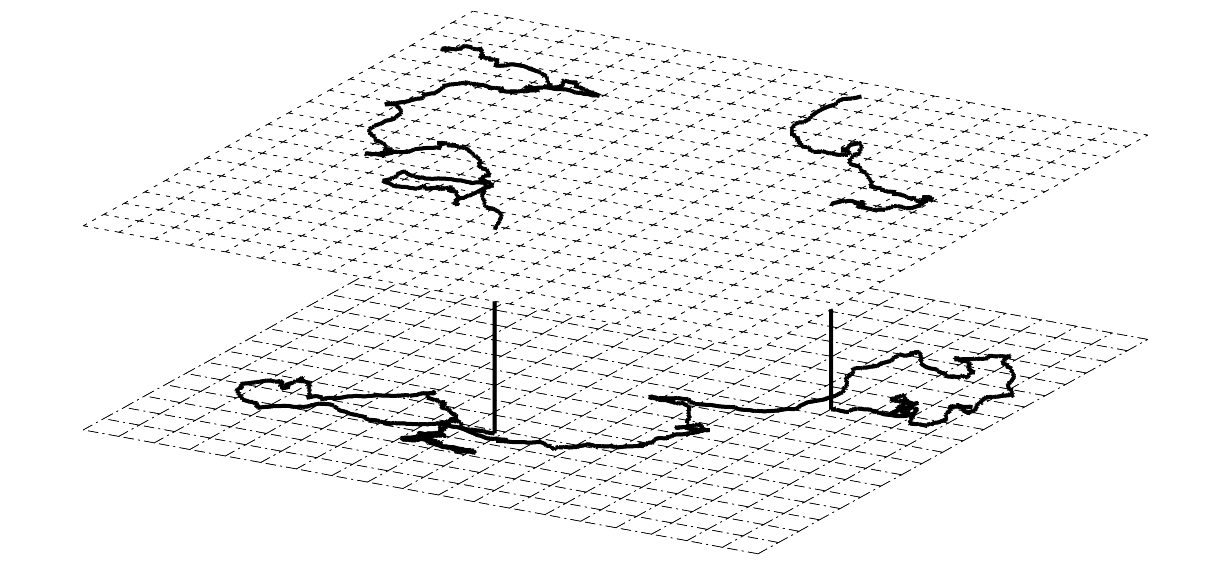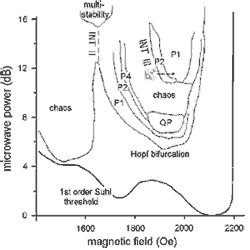Research projects
- Current projects
-
Previous projects
- Long-term behaviour of large dynamical systems
- Modeling of fast chaotic degrees of freedom by stochastic processes
- Investigation of nonlinear-dynamic effects in maintenance
- Control of extended fast complex systems with spatiotemporal delayed feedback
- Improvement of the cutting quality of Abrasive Waterjet Cutting with methods of Nonlinear Dynamics
- Analysis of hidden diffusion processes
- Methods of system adaption
Current projects
Diffusion and Trapping in Confined Liquid Films and at Interfaces
Funded within the Saxon research unit 877 "From Local Constraints to Macroscopic Transport"
Subproject P4 "Diffusion and Trapping in Confined Liquid Films and at Interfaces"
Project Leader: Prof. Dr. Günter Radons
Experimentally observed diffusion is only seen as a two-dimensional projection from a basically three-dimensional space. Composite Markov processes which are supposed to be able to explain these basic experimental results yield predictions about typical time and length scales. These are compared to the experiment, where for layering systems the diffusion coefficients depend on the observed time or space window.

Furthermore the evaluation of the range of applicability of composite Markov processes is investigated.
For thin liquid films we expect to get sensible results for the diffusion coefficients
and transition rates of the real system. For thicker liquid films the simple approach
with discrete layers is supposed to fail for the layers farthest away from the solid interface,
where a transition to bulk diffusion is expected.
Thus, a full three-dimensional continuum model using a 3-d Fokker-Planck equation
for the stochastic motion is more appropriate.
In cooperation with the group
Optical Spectroscopy and Molecular Physics previously hidden details are extracted
from experiments to develop an optimized analysis scheme for optical single molecule tracking data.
This should help to separate effects of the diffusant/liquid and the diffusant/substrate
interactions.
Hyperbolicity and Lyapunov-Analysis
Details can be found in our group brochure (PDF).Pattern Formation in Systems with Fluctuating Delay
Details can be found in our group brochure (PDF).Stability of Cutting Processes
Details can be found in our group brochure (PDF).Chaos in Disordered Hamiltonian Systems
Details can be found in our group brochure (PDF).Anomalous Transport
Details can be found in our group brochure (PDF).Dynamics of hysteretic systems
Hysteresis is a very general phenomenon occurring beyond physics and chemistry in interrelations in engineering, social, and economic science. In many branches of science Preisach-type models of hysteresis are applied to complex, non-local hysteresis successfully.
We are interested in coupling of dynamical systems (iterated maps and PDEs) with hysteresis of Preisach-type. Additionally randomly driven hysteresis is part of our research focus. Recent investigations made sicnificant insights into the origin and impact of hysteresis long-term memory.
In addition, see:- G. Radons, Hysteresis-Induced Long-Time Tails, Phys. Rev. Lett. 100, 240602 (2008). Abstract
- Press release by Chemnitz UT, September 8, 2008: Das Gedächtnis von Arbeitslosigkeit und Hochwasser berechnen (PDF)
- page 6 f. in our group brochure (PDF)
Previous projects
Long-term behaviour of large dynamical systems
Project leader: Prof. Dr. Günter Radons
Contact: Dr. Hong-liu Yang , Dipl. Phys. Christian Drobniewski
Details can be found in the german version of this site.
Modeling of fast chaotic degrees of freedom by stochastic processes
Cooperation with the Research Group "Nonlinear dynamics and time series analysis", Max Planck Institute for the Physics of Complex Systems and the group Dynamical Systems at Queen Mary / University of London supported by the German Research Foundation
Project leader: PD Dr. Wolfram Just, Prof. Dr. Holger Kantz, Prof. Dr. Günter Radons
Contact: Dr. Katrin Gelfert
Details can be found in the german version of this site.
Investigation of nonlinear-dynamic effects in maintenance
Interdisciplinary priority program of the Volkswagen Foundation "Investigations of Non-linear Dynamic Effects in Production Systems"
Project leader: Prof. Dr. Berend Denkena , Prof. Dr. Hans Kurt Tönshoff, Prof. Dr. Günter Radons
Contact: Dipl. Phys. André Löser
Details can be found in the german version of this site.
Control of extended fast complex systems with spatiotemporal delayed feedback
Cooperation with the group " Nonlinear Spin Dynamics", Institute of Condensed Matter Physics, TU Darmstadt and supported by the German Research Foundation
Project leader: Prof. Dr. Hartmut Benner, PD Dr. Wolfram Just, Prof. Dr. Günter Radons
The main scope of the project is control in spatially extended chaotic systems using spatiotemporal delayed feedback. New and robust control methods will be developed for the stabilisation of fast spatiotemporal structures. From the experimental point of view complex electronic networks and ferromagnetic films are of main interest. Based on analytical approaches, numerical simulations, and real experiments we investigate how limitations, e.g. of topological origin, can be relaxed by modifications of the control method. As an application we intend to select and stabilise dynamical patterns in yttrium iron garnet (YIG) films beyond the first order Suhl threshold.

Improvement of the cutting quality of Abrasive Waterjet Cutting with methods of Nonlinear Dynamics
Funded until 2005 within the interdisciplinary priority program of the Volkswagen Foundation "Investigations of Non-linear Dynamic Effects in Production Systems"
Project leader: Prof. Dr. Engelbert Westkämper, Prof. Dr. Günter Radons
Details can be found in the german version of this site.
Analysis of hidden diffusion processes
Funded until 2004 within the
interdisciplinary DFG Priority Program 1114 "Mathematical Methods for Time Series Analysis and Digital Image Processing"
http://www.math.uni-bremen.de/zetem/DFG-Schwerpunkt/
Project leader: Prof. Dr. Günter Radons
Contact: Dr. Abdelhadi Benabdallah
Diffusion processes, continuous in time and space, often cannot be observed directly but only via functions reflecting the measurement process. We investigate the parameter estimation problem for hidden diffusion processes in a periodic potential. We propose a discrete model as an approximation of continuous partially observed diffusion processes. Using the Baum-Welch algorithm we estimate the drift and the diffusion parameters which characterize the diffusing state variable via an approximation by a discrete random walk. Numerical results confirm our analytical estimation.
More details can be found in the german version of this site.
Methods of system adaptions
Details can be found in the german version of this site.





